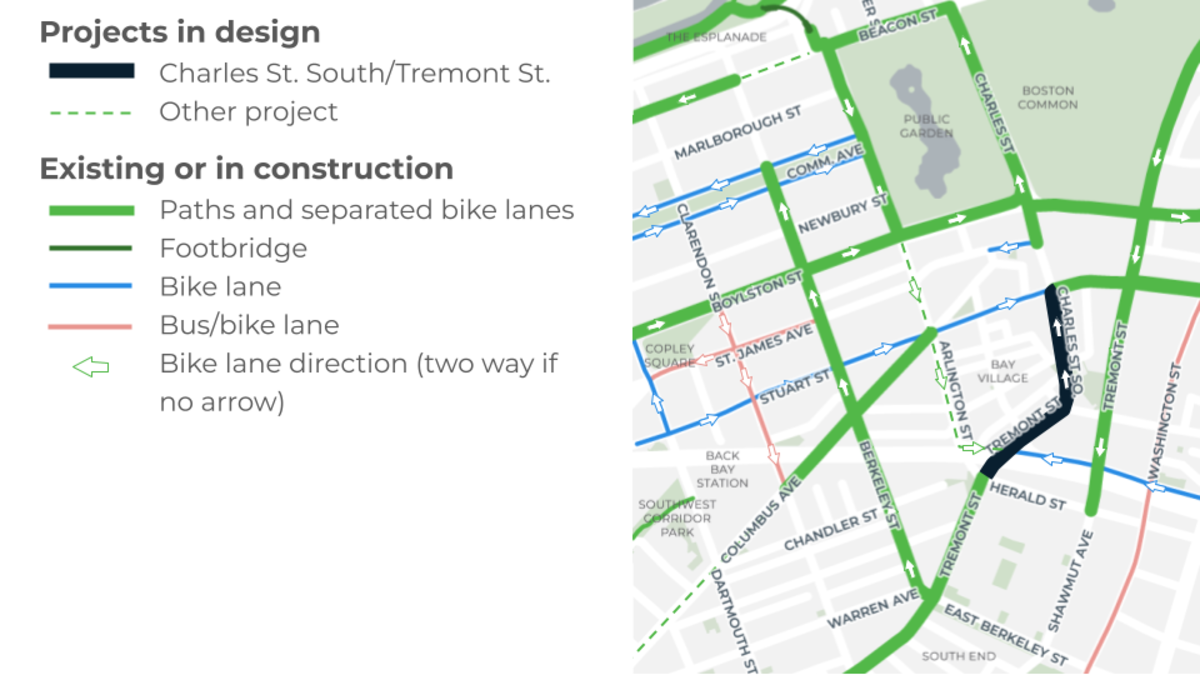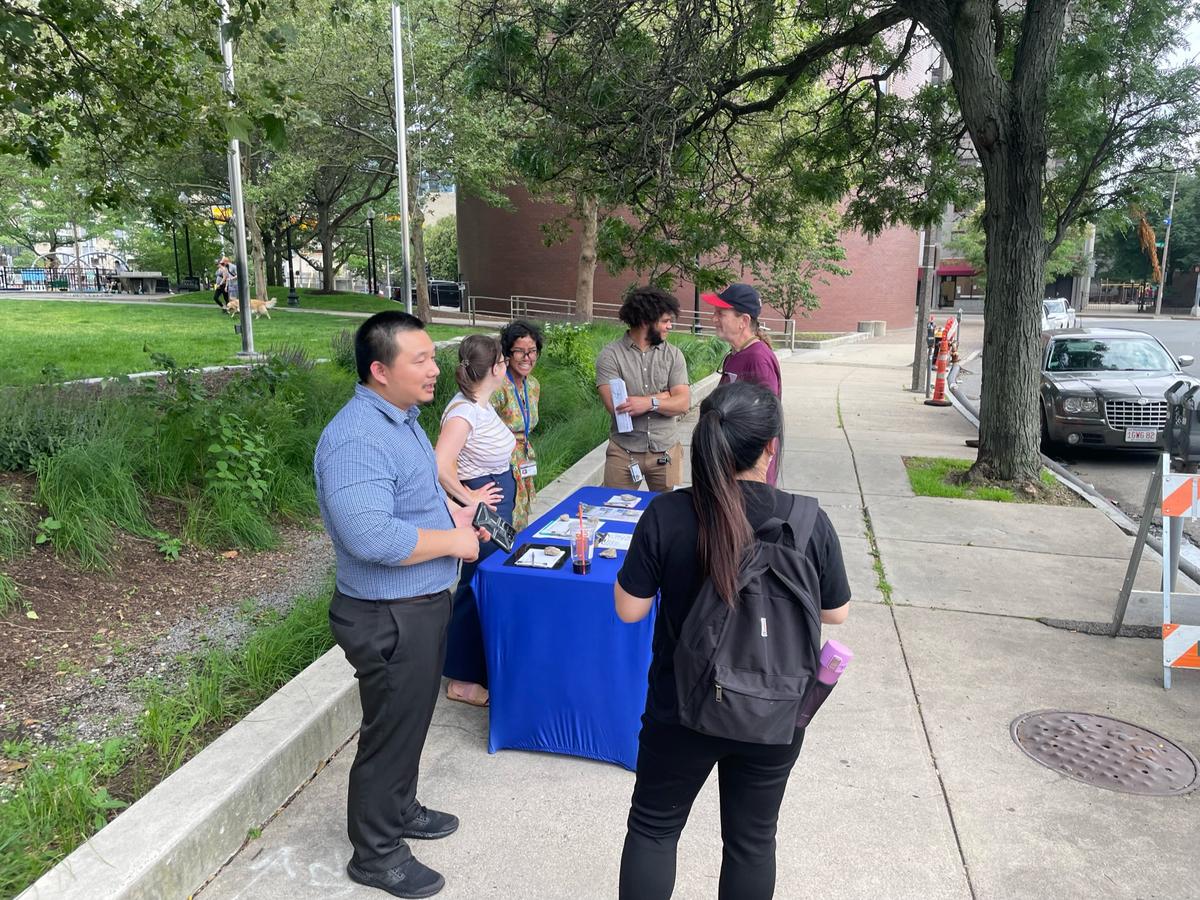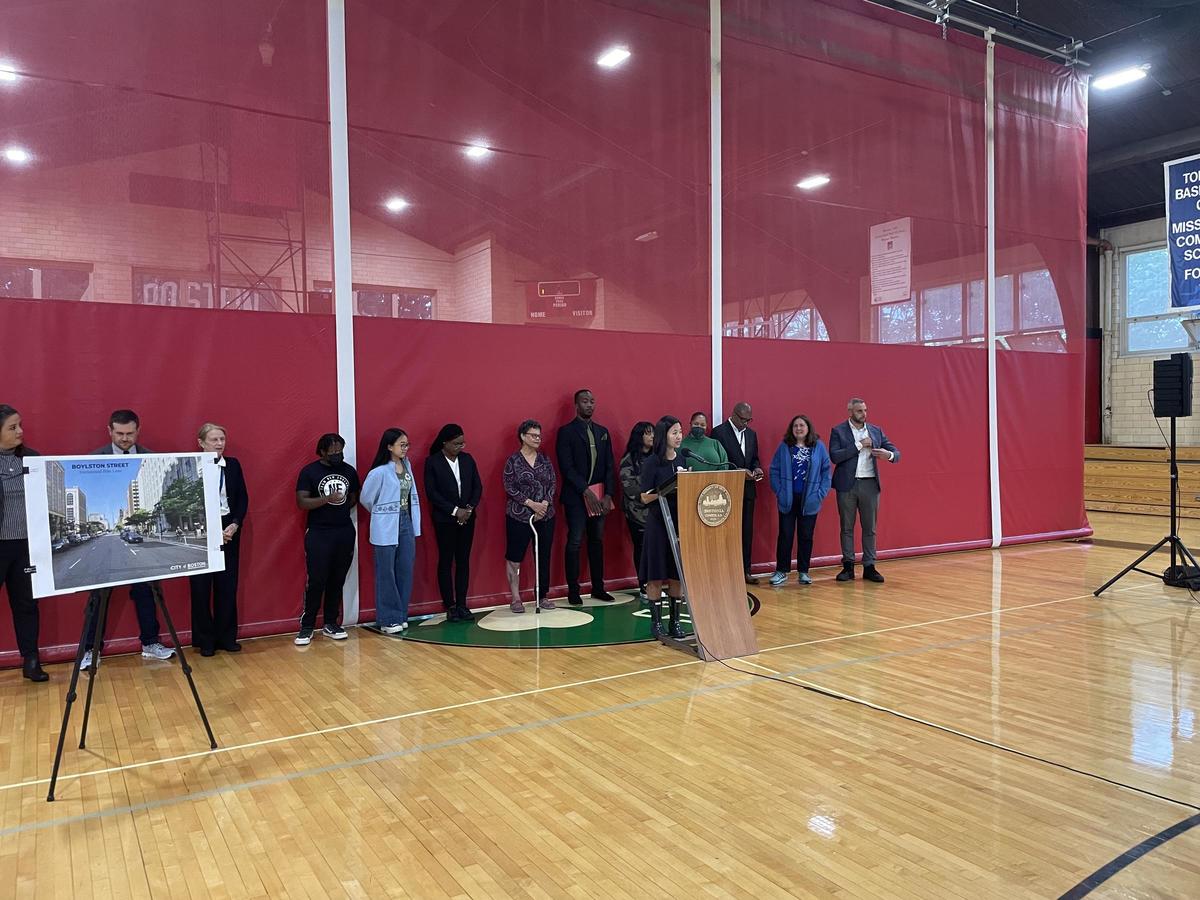Connect Downtown: Charles Street South and Tremont Street
Let’s design a safer Charles Street South and Tremont Street!
Our vision for Charles Street South and Tremont Street
- Pedestrian safety. Make it safer and easier for you to cross Charles Street South, Tremont Street, and Arlington Street.
- Accessibility. Rebuild curb ramps that do not meet accessibility standards.
- Connected bicycle network. Close gaps in the local bicycle network, prioritizing safe, all-ages and abilities bike lanes.
- Traffic and parking. Accommodate existing traffic volumes and maximize parking while prioritizing safer street designs.
Events
EventsThere are no related events available at this time!
Design Approach
We will post a link to the design plans here when they are ready.
- Curb Ramps: We'll rebuild ramps and surrounding sidewalk areas.
- Some crosswalks will be moved to better reflect where people naturally want to cross the street.
- Materials will match applicable historic district guidelines.
- Smoother Road: The road between Marginal Road and Stuart Street will be repaved with fresh pavement, making a more comfortable experience for all users.
- Separated bike lanes:
- Tremont Street (Herald Street to Charles Street South): We'll add one-way separated bike lanes on both sides of the street, allowing travel in both directions.
- Charles Street South (Tremont Street to Stuart Street): We'll add a one-way separated bike lane allowing travel on the northbound direction only. The lane will connect to the existing separated bike lane on Stuart Street going eastbound. The bike lane will be on the east side of the street next to Eliot Norton Park.
- Traffic and capacity:
- Tremont Street (Herald Street to Charles Street): Traffic will continue to flow in both directions on this section, just like it does now.
- Charles Street South (Tremont Street to Warrenton Street): We're making this section safer for you to cross the street by reducing the number of lanes from three to one. Traffic data shows that one lane will be enough to handle the current traffic volume. This section will stay one-way northbound.
- Charles Street South (Warrenton St. to Stuart St.): This section will have two northbound lanes instead of three. This allows room for vehicles to wait at the traffic light at Stuart Street. This section will stay one-way northbound.
- Parking: We understand the importance of on-street parking to the community. We are working on solutions that will improve pedestrian safety while keeping as much parking available as possible. We will share more details about these options soon.
Project map
The project area includes:
- Tremont Street between Herald Street to Charles Street South
- Charles Street South between Tremont Street and Stuart Street
Project updates
UpdatesWe attended the Bay Village Neighborhood Association Executive Committee Monthly Meeting on August 14, 2023. We shared a presentation that covered existing conditions and a conceptual design and took your questions.
On Tuesday, June 27, and Tuesday, July 18 we hosted drop-by office hours on Charles Street South near the corner of Warrenton Street. We shared an updated version of our "starter ideas" handout that included new information about existing traffic patterns. An interpreter was available for Cantonese speakers. Thank you to all who dropped by.
On Saturday, April 29 we hosted a community walk. We gathered at the corner of Charles Street South and Melrose Street at 10:30 a.m. An interpreter was available for Cantonese speakers. We shared "starter ideas" for Charles Street South and Tremont Street. Thank you to all who attended.
Thank you to everyone who has shared their experiences and goals for Charles Street South & Tremont Street. Here's what you told us:
- Charles Street South is "like a highway that has no traffic." Drivers go too fast and the street is wider than it needs to be.
- It should feel easier and safer to cross the street, especially at the crosswalk at Melrose Street and Warrenton Street.
- Changes to the number of parking spaces should be minimized as much as possible.
- Preference for "Starter idea #2" for Charles Street South between Tremont Street and Melrose Street: one general travel lane going northbound, a one-lane pedestrian crossing, and parking protected bike lane.
We started community engagement and design work for Charles Street South/Tremont Street.
- We mailed 2,104 postcards to addresses in Chinatown and Bay Village. It includes information in English and Traditional Chinese.
-
We distributed flyers to abutters, posted them in high-visibility locations, and sent them electronically to community groups.
-
We talked to ground floor businesses along the corridor.
To build on her commitment to create safe streets for all modes of transportation, Mayor Michelle Wu and the Boston Transportation Department (BTD) announced a 9.4 mile expansion of bike lanes providing key connections within the City’s existing bike network and the launch of a Citywide design process to bring safer streets to every neighborhood. To do this, Boston is expanding Bluebikes to accommodate rising demand, designing traffic-calmed streets by building speed humps and raised crosswalks, and hiring more staff to aid in the design process.
The announcement was covered by local news outlets.
We held a series of virtual office hours during Fall 2020. You were invited to sign up for a 15-minute appointment during the listed hours with a member of the project team. Appointments were available online or over the phone. You brought your questions and reviewed information related to the project
Appointments were available on Wednesday afternoons during September and October:
- September 16, 3 - 7 p.m.
- September 23, 3 - 7 p.m.
- September 30, 3 - 7 p.m.
- October 7, 3 - 7 p.m.
- October 14, 3 - 7 p.m.
- October 21, 3 - 7 p.m.
- October 28, 3 - 7 p.m.
We hosted three outdoor information sessions. We shared information about the upcoming changes to traffic signals and new bike lanes. We answered questions and gathered your feedback. We engaged with people in English, Spanish, and Cantonese.
Meeting announcements were shared via a direct mailing, our email list, a press release, and City social media accounts. We followed state and City guidelines for meetings. All attendees wore a face covering and stood six feet apart.
We planned a series of Open Houses in March and expanded Office Hours into the spring. We were able to hold one Open House before in-person meetings were suspended. More than 45 people stopped by the event on March 5 at the Central Library.
The content shared at this Open House is available to explore online.
You were invited to drop in any time during office hours and talk one-on-one with us. You could review project materials, ask questions, and share your feedback. We hosted Office Hours weekly between January 8 and March 4 at the Boston Public Library’s Central Library and West End Library. We talked with 257 community members during our office hours. You shared almost 200 comments with us. We suspended Office Hours in early March because of COVID-19.
View the project fact sheet (PDF)
We hosted a series four of community walks during the fall of 2019. The walks covered neighborhoods and streets we are looking at as part of Connect Downtown. We invited community members to attend and share their experiences walking and biking in the study area.
Scroll down to read about each walk.
Beacon Hill
Saturday, November 2, 2019
- Intersections like Beacon Street at Charles Street and Charles Circle feel like barriers for people walking because of long wait times or unclear pedestrian signals.
- Desire for more pedestrian space and pedestrian-only events on Charles Street north of Beacon Street.
- Concern about excessive speeding on Charles Street south of Beacon Street and Beacon Street east of Charles Street.
- Some people want to bike but don't feel comfortable with the busy streets and intersections. People who bike now sometimes use the Common and sidewalks because they don't feel safe on the street.
- The curbside on Charles Street north of Beacon Street should be better managed to reduce double parking and provide space for commercial loading and passenger pickup and dropoff.
"People come [to Charles Street] for the pedestrian experience."
"This [crosswalk between the Boston Common and Public Garden] is a special place, a major gateway between two iconic, historic open spaces—and should look like it!"
"Biking from the West End to Copley Square is easy but biking back is very hard because of one-way streets."
"I don't usually have sympathy for bikers, but this area needs bike lanes!"
Back Bay
Thursday, November 7, 2019
- Walk signals are different at each intersection. Locals have learned how they work, but visitors find them confusing. The inconsistency erodes confidence in the signals. People make their own decisions about when to cross.
- The Beacon Street, Arlington Street, Mugar Way intersection is stressful for people walking because of long wait times, confusing signals, and multi-stage crossings via small islands.
- Many people bike in the area but the streets and intersections are not designed for them. As a result, people who bike have developed their own strategies to navigate the area. Some feel like the only "safe" option is to go during the pedestrian signal to avoid stressful interactions with vehicles.
- People often bike across the plaza on the southwest corner of Charles Street South and Boylston Street to get to Columbus Ave and continue to the Southwest Corridor. They are avoiding the stressful weave from Stuart Street to Charles Street South to Park Plaza.
"Consistency in walk signals is important. It gives pedestrians confidence."
"Can we put a big crosswalk in the middle of the intersection so you can cross directly from the Public Garden to the Commonwealth Ave Mall?"
"Being on the island in the middle of the intersection [of Beacon Street and Arlington Street] is like being a penguin on an iceberg with rising sea levels."
"It's common to see bicyclists cut across the intersection [of Boylston Street at Charles Street] and use the sidewalk to get to Columbus Ave [heading southwest]."
South End
Wednesday, November 13, 2019
- Walk signals are inconsistent. Some are concurrent with vehicles while others are exclusive. People find this confusing. Some make their own choices about when and where to cross.
- The sidewalks on Columbus Ave are narrow and feel congested, especially during peak travel hours. Nearby Back Bay Station is a major draw for people walking.
- Columbus Ave is an important bike route through the city. In the South End, bike commuters choose Columbus Ave over the Southwest Corridor Park because it's a direct connection between downtown and neighborhoods to the southwest.
- Desire for better bike lanes on Columbus Avenue. The existing bike lanes on southwest of Dartmouth Street feel too narrow and are often blocked by doubled-parked cars. Northeast of Dartmouth Street, there are no bike lanes.
"We should embrace the cold weather. Can we have car-free street events during the winter?"
"Can we make the intersections more compact and feel human-scaled?"
"Sidewalks [on Columbus Ave] between Clarendon and Berkeley are very congested, particularly when trains let out at Back Bay Station."
"Can we reduce the number of travel lanes on Columbus Ave northeast of Dartmouth Street so we can have separated bike lanes? There could be a left turn lane at Berkeley Street for the [Route 39] bus and drivers going to Storrow Drive."
Bay Village/Chinatown
Tuesday, December 10
- Walk signals are too short and infrequent. People who aren't able to walk fast have to wait for two full cycles.
- Some unsignalized crosswalks are stressful to use because there are many lanes and drivers go fast. Examples include Tremont Street at the Tufts Medical Center garage, Charles Street South at Melrose Street, and Arlington Street at Isabella Street.
- In some places, many people cross the street but there is no crosswalk. Examples include Boylston Street mid-way between Tremont Street and Charles Street, Stuart Street at Warrenton Street, and Charles Street South at Park Plaza.
- Stuart Street, Charles Street South, Boylston Street, and Tremont Street are important bike routes in the city but don't have bike facilities.
- People who bike find some intersections very stressful because of turning or weaving traffic. To avoid conflicts with vehicles, some choose to go during the pedestrian phase.
"The north-south crossing on the east side of Arlington Street at Stuart Street has a staggered pedestrian crossing. You get stuck in the middle. It's difficult."
"Exclusive pedestrian phases are too short with too long of a wait in between."
"The turn from Stuart Street onto Charles Street South is scary as a bicyclist. You have to weave across a bunch of lanes. This results in people going when they feel safe based on their ability level, including on the walk signal."
"This area is very very loud because of cars, trucks, and sirens. We have had to shout to hear each other this entire walk!"
"Can we do something to manage pickup and dropoff traffic? Tremont Street south of Stuart Street gets really congested with Ubers when theater shows start or finish."











